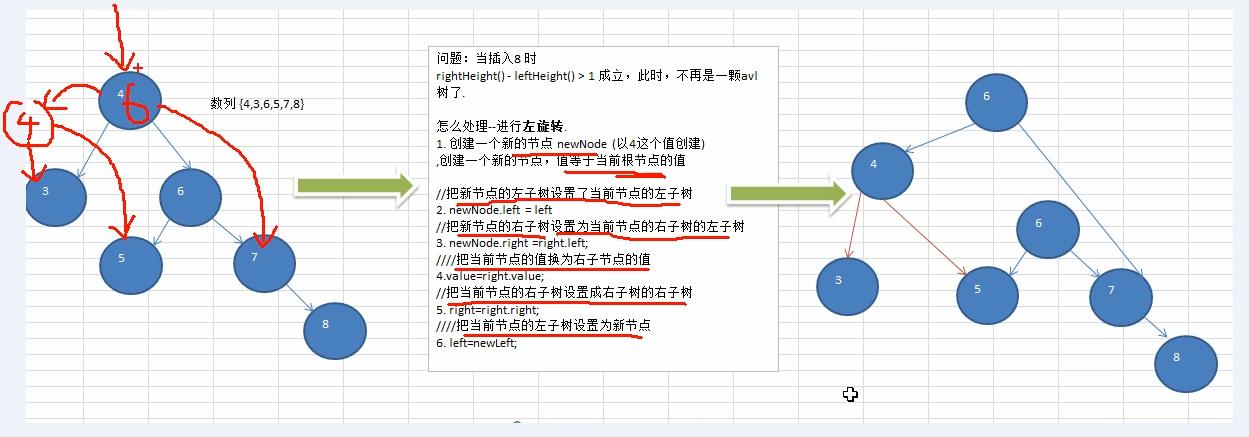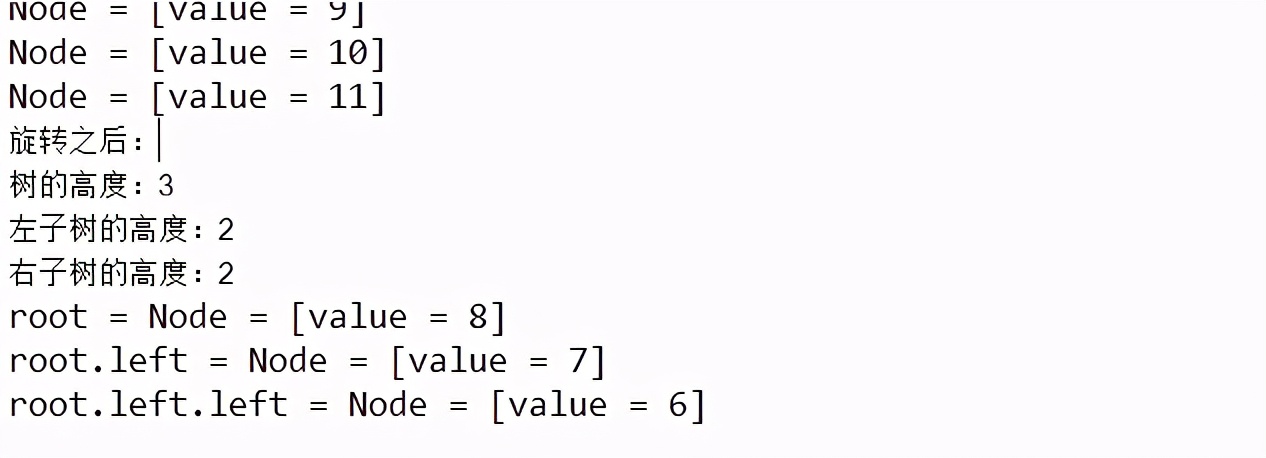Java树结构实际应用(平衡二叉树/AVL树)
Posted Javachichi
tags:
篇首语:本文由小常识网(cha138.com)小编为大家整理,主要介绍了Java树结构实际应用(平衡二叉树/AVL树)相关的知识,希望对你有一定的参考价值。
平衡二叉树(AVL 树)
1 看一个案例(说明二叉排序树可能的问题)
给你一个数列{1,2,3,4,5,6},要求创建一颗二叉排序树(BST), 并分析问题所在.
左边 BST 存在的问题分析:
-
左子树全部为空,从形式上看,更像一个单链表.
-
插入速度没有影响
-
查询速度明显降低(因为需要依次比较), 不能发挥 BST
的优势,因为每次还需要比较左子树,其查询速度比
单链表还慢
- 解决方案-平衡二叉树(AVL)
2 基本介绍
-
平衡二叉树也叫平衡二叉搜索树(Self-balancing binary search tree)又被称为 AVL 树, 可以保证查询效率较高。
-
具有以下特点:它是一 棵空树或它的左右两个子树的高度差的绝对值不超过 1,并且左右两个子树都是一棵
平衡二叉树。平衡二叉树的常用实现方法有红黑树、AVL、替罪羊树、Treap、伸展树等。
- 举例说明, 看看下面哪些 AVL 树, 为什么?

3 应用案例-单旋转(左旋转)
-
要求: 给你一个数列,创建出对应的平衡二叉树.数列 {4,3,6,5,7,8}
-
思路分析(示意图)

3)代码实现
// 左旋转
private void leftRotate() {
// 创建新的节点,以当前根节点的值
SNode newNode = new SNode(value);
// 把新的节点左子树设置成当前节点的左子树
newNode.left = left;
// 把新节点的右子树设置成当前节点的右子节点的左子树
newNode.right = right.left;
// 把当前节点的值换为右子节点的值
value = right.value;
// 把当前节点的右子树换成右子树的右子树
right = right.right;
// 把当前节点的左子树设置成新节点
left = newNode;
}
4 应用案例-单旋转(右旋转)
-
要求: 给你一个数列,创建出对应的平衡二叉树.数列 {10,12, 8, 9, 7, 6}
-
思路分析(示意图)

3)代码实现
// 右旋转
private void rightRotate() {
SNode newNode = new SNode(value);
newNode.right = right;
newNode.left = left.right;
value = left.value;
left = left.left;
right = newNode;
}
5 应用案例-双旋转
前面的两个数列,进行单旋转(即一次旋转)就可以将非平衡二叉树转成平衡二叉树,但是在某些情况下,单旋转
不能完成平衡二叉树的转换。比如数列
int[] arr = { 10, 11, 7, 6, 8, 9 }; 运行原来的代码可以看到,并没有转成 AVL 树.
int[] arr = {2,1,6,5,7,3}; // 运行原来的代码可以看到,并没有转成 AVL 树
1) 问题分析

2) 解决思路分析
1. 当符号右旋转的条件时
2. 如果它的左子树的右子树高度大于它的左子树的高度
3. 先对当前这个结点的左节点进行左旋转
4. 在对当前结点进行右旋转的操作即可
3) 代码实现[AVL 树的汇总代码(完整代码)]
package com.lin.avltree_0316;
import javax.security.auth.kerberos.KerberosKey;
public class AVLTreeDemo {
public static void main(String[] args) {
// int[] arr = {4, 3, 6, 5, 7, 8};
// int[] arr = {10, 12, 8, 9, 7, 6};
int[] arr = {10, 11, 7, 6, 8, 9};
AVLTree avlTree = new AVLTree();
for (int i = 0; i < arr.length; i++) {
avlTree.add(new SNode(arr[i]));
}
avlTree.infixOrder();
System.out.println("旋转之后:");
System.out.println("树的高度:" + avlTree.getRoot().height());
System.out.println("左子树的高度:" + avlTree.getRoot().leftHeight());
System.out.println("右子树的高度:" + avlTree.getRoot().rightHeight());
System.out.println("root = " + avlTree.getRoot());
System.out.println("root.left = " + avlTree.getRoot().left);
System.out.println("root.left.left = " + avlTree.getRoot().left.left);
}
}
class AVLTree{
private SNode root;
// 查找要删除的节点
public SNode getRoot() {
return root;
}
public SNode searchDelNode(int value) {
if(root == null) {
return null;
} else {
return root.searchDelNode(value);
}
}
// 查找要删除节点的父节点
public SNode searchParent(int value) {
if(root == null) {
return null;
} else {
return root.searchParent(value);
}
}
/**
* @param node 传入的节点(当作二叉排序树的根节点)
* @return 返回的以node为根节点的二叉排序树的最小节点的值
*/
public int delRightTreeMin(SNode node) {
SNode target = node;
// 循环地查找左节点,就会找到最小值
while(target.left != null) {
target = target.left;
}
delNode(target.value);// !!!!
return target.value;// !!!!!
}
// 删除节点
public void delNode(int value) {
if(root == null) {
return;
} else {
// 找删除节点
SNode targetNode = searchDelNode(value);
// 没有找到
if(targetNode == null) {
return;
}
// 如果发现当前这棵二叉树只有一个节点
if(root.left == null && root.right == null) {
root = null;
return;
}
// 去找到targetNode的父节点
SNode parent = searchParent(value);
// 如果删除的节点是叶子节点
if(targetNode.left == null && targetNode.right == null) {
// 判断targetNode是父节点的左子节点还是右子节点
if(parent.left != null && parent.left.value == value) {
parent.left = null;
} else if(parent.right != null && parent.right.value == value) {
parent.right = null;
}
} else if(targetNode.left != null && targetNode.right != null) { // 有左右子节点
int delRightTreeMin = delRightTreeMin(targetNode.right);
targetNode.value = delRightTreeMin;
} else {// 只有一个子节点
// 要删除的节点只有左节点
if(targetNode.left != null) {
if(parent != null) {
// 如果targetNode是parent的左子节点
if(parent.left.value == value) {
parent.left = targetNode.left;
} else {
parent.right = targetNode.left;
}
} else {
root = targetNode.left;
}
} else {// 要删除的节点有右子节点
if(parent != null) {
if(parent.left.value == value) {
parent.left = targetNode.right;
} else {
parent.right = targetNode.right;
}
} else {
root = targetNode.right;
}
}
}
}
}
// 中序遍历
public void infixOrder() {
if(root == null) {
System.out.println("空树!");
} else {
root.infixOrder();
}
}
// 添加
public void add(SNode node) {
if(root == null) {
root = node;
} else {
root.add(node);
}
}
}
class SNode{
protected int value;
protected SNode left;
protected SNode right;
public SNode(int value) {
// TODO Auto-generated constructor stub
this.value = value;
}
// 返回左子树的高度
public int leftHeight() {
if(left == null) {
return 0;
}
return left.height();
}
// 返回右子树的高度
public int rightHeight() {
if(right == null) {
return 0;
}
return right.height();
}
// 返回当前节点的高度,以该节点为根节点的树的高度
public int height() {
return Math.max(left == null ? 0: left.height(), right == null ? 0 : right.height()) + 1;
}
// 左旋转
private void leftRotate() {
// 创建新的节点,以当前根节点的值
SNode newNode = new SNode(value);
// 把新的节点左子树设置成当前节点的左子树
newNode.left = left;
// 把新节点的右子树设置成当前节点的右子节点的左子树
newNode.right = right.left;
// 把当前节点的值换为右子节点的值
value = right.value;
// 把当前节点的右子树换成右子树的右子树
right = right.right;
// 把当前节点的左子树设置成新节点
left = newNode;
}
// 右旋转
private void rightRotate() {
SNode newNode = new SNode(value);
newNode.right = right;
newNode.left = left.right;
value = left.value;
left = left.left;
right = newNode;
}
@Override
public String toString() {
// TODO Auto-generated method stub
return "Node = [value = " + value + "]";
}
// 添加节点
public void add(SNode node) {
if(node == null) {
return;
}
if(node.value < this.value) {
if(this.left == null) {
this.left = node;
} else {
this.left.add(node);
}
} else {
if(this.right == null) {
this.right = node;
} else {
this.right.add(node);
}
}
// 当添加完后,如果右子树的高度-左子树的高度 > 1, 左旋转
if( ( rightHeight() - leftHeight() ) > 1 ) {
// 如果当前节点的右子树的左子树高度大于右子树的高度
if(right != null && (right.leftHeight() > rightHeight() ) ) {
right.rightRotate();
leftRotate();
} else {
leftRotate();
}
return;//!!!!
}
if ((leftHeight() - rightHeight()) > 1) {
// 如果当前节点的左子树的右子树高度大于左子树的高度
if (left != null && (left.rightHeight() > left.leftHeight())) {
// 先对当前节点的左节点进行左旋转
left.leftRotate();
// 再对当前节点进行右旋转
rightRotate();
} else {
rightRotate();
}
}
}
// 中序遍历
public void infixOrder() {
if(this.left != null) {
this.left.infixOrder();
}
System.out.println(this);
if(this.right != null) {
this.right.infixOrder();
}
}
// 查找要删除的节点
public SNode searchDelNode(int value) {
if(this.value == value) {
return this;
} else if(this.value > value) {
// 如果左子节点为空
if(this.left == null) {
return null;
}
return this.left.searchDelNode(value);
} else {
if(this.right == null) {
return null;
}
return this.right.searchDelNode(value);
}
}
// 查找要删除节点的父节点, 如果没有则返回null
public SNode searchParent(int value) {
if(( this.left != null && this.left.value == value)
|| ( this.right != null && this.right.value == value )) {
return this;
} else {
// 如果查找的值小于当前节点的值,并且当前节点的左子节点不为空
if(value < this.value && this.left != null) {
return this.left.searchParent(value);
} else if(value >= this.value && this.right != null) {
return this.right.searchParent(value);
} else {
return null;
}
}
}
}

拓展干货阅读:一线大厂面试题、高并发等主流技术资料
文章来源:头条——我不秃头
以上是关于Java树结构实际应用(平衡二叉树/AVL树)的主要内容,如果未能解决你的问题,请参考以下文章